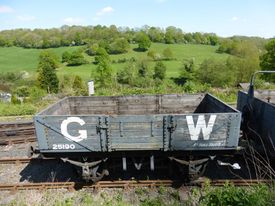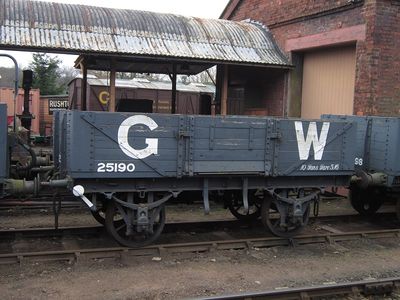GWR 25190 5 plank Open Goods Wagon
| GWR 25190 5 plank Open Goods Wagon | |
|---|---|
 GWR 25190 5 plank Open Goods Wagon | |
| Built By | GWR Swindon |
| Status | Operational |
| Number | 25190 |
| History | |
| Built | 1904 |
| Diagram | O4 |
| Lot | 455 |
| Type | 4-w 5-plank Open |
| Capacity | 10 tons |
| Telegraphic code | OPEN A |
| Brakes | DC brakes |
| 1937 | Overhauled for use at Sharpness docks |
| 1986 | Arrived on SVR |
| 1987 | Restored |
| 2008 | Overhauled |
5-plank wagons were first built in 1902-1904 to Diagram 04, with the fifth plank giving a 2ft 11in inside height. They were the first wagons to be fitted with Williams Patent sheet supporters; before that time tarpaulins were simply draped over the wagon. (Tarpaulins tended to form pinholes over time, even with careful use. With a ridge sheet support fitted, water would run straight off the tarpaulin; without such a support the tarpaulin tended to form hollows where water could collect and seep through the pin holes onto the goods below).[1] The wagons were not vacuum fitted, the presence of the sheet support and absence of vacuum brakes being signified by the type OPEN A
Contents
Contents
Service
25190 was built at Swindon in 1904 as part of Lot 455 to Diagram O4.[2] 25190 and 41277 were both sold out of GWR service in the mid-1930s and acquired for use at Sharpness Docks,[3] and was rebuilt in 1937 as part of Lot 1249[4].
Preservation
25190 was acquired from the then British Waterways Board's Sharpness Docks by the The GWR 813 Preservation Fund in 1986. Although in relatively poor structural condition, it was considered worthy of preservation as one of only a handful of vehicles still in existence with the original pattern of GWR "Dean-Churchward" ratchet brake.[5] It arrived on the SVR on 16 December 1986,[6] accompanied by another similar wagon number 13260. The latter was accepted on the understanding that it was unsuitable for restoration and would be dismantled to provide spare parts.[5]
13260 was quickly dismantled, although it did not provide a spring eye bolt (two of which connect each carrying spring to the underframes). Two recent failures on other wagons through a combination of overloading and old age had exhausted the remaining stock of these, requiring new bolts to be manufactured.[5]
25190's poor condition meant its restoration would need to be funded by the owning group. By mid-1987, heavy expenditure on 143 and 943286 meant further overhauls of other existing vehicles could not proceed without a significant budget overspend. The restoration of 25190 and 2424 were therefore brought forward as both would be funded by the owning group, with work on 25190 beginning in Whitsun week. Rotten areas of the steelwork were removed, as was all the remaining original timber. One headstock was replaced using retrieved channel section from an LMS coach frame cut up on the old Stourport line some years before. Refurbished drawgear springs were fitted along with drawhooks salvaged from 13260. A complete new floor has been made out of Keruing, although the majority of the side and end planks came from a supply of second-hand timber obtained from the Port of Bristol Authority. The restoration was completed at the end of 1987.[7]
It received a further overhaul in 2008. Several of the second-hand planks previously fitted required replacement, along with a couple of floor planks which had been damaged by loading, and subsequently started to rot. A bracket between one headstock and solebar, which had become severely corroded, was removed and a replacement fabricated and riveted in. A welded repair was also carried out to a localised area of corrosion on the other headstock. 25190 was then completely repainted.[8]
2519 is owned by The GWR 813 Preservation Fund. It is in serviceable condition, although is no longer fitted with a sheet rail.
See also
References
- ↑ Atkins, Beard & Tourret (2013) p. 2.
- ↑ Atkins, Beard & Tourret (2013) p. 27.
- ↑ National Preservation Forum 'SVR wagons 2010 thread
- ↑ Railway Heritage Register Wagon Survey
- ↑ 5.0 5.1 5.2 SVR News 84
- ↑ SVR Stock Book Ninth Edition
- ↑ SVR News 86
- ↑ SVR News 163
